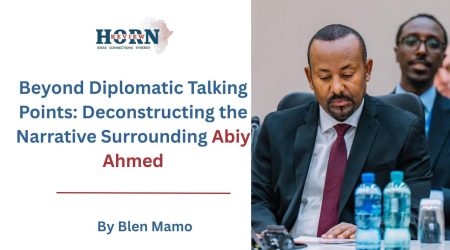
31
May
From Hijra to Hesitation: Ethiopia’s Absence in the Muslim World’s Premier Body, the Organisation of Islamic Cooperation
Ethiopia, often referred to as the cradle of humanity, holds a unique and significant place in the history of Islam – one that predates many of the current member states of the Organization of Islamic Cooperation (OIC). It is the land where Islam found its first refuge, offering sanctuary to early Muslims fleeing persecution. Despite this foundational connection, and with over 31% of its population identifying as Muslim, Ethiopia remains outside the formal fold of the OIC – an organization that claims to represent the collective voice of the Muslim world.
This glaring absence raises difficult questions. Why has a nation with such deep-rooted Islamic heritage and a substantial Muslim demographic never joined an organization that includes states with far smaller Muslim populations and more limited historical connections to the faith? This paradox invites scrutiny, prompting a re-examination of Ethiopia’s identity, its foreign policy posture, and the internal politics of the OIC itself.
The story of Islam in Ethiopia begins not with conquest but with compassion. In the 7th century, when the nascent Muslim community in Mecca faced persecution, the Prophet Muhammad instructed his followers to seek refuge in Abyssinia – ancient Ethiopia – under the just rule of the Christian king, Negus (Najashi). This event, known as the First Hijra, is enshrined in Islamic tradition as an early and noble chapter in the history of the faith. Ethiopia became a symbol of interfaith solidarity, known in Islamic scholarship as Dar al-Hijratayn – the land of two migrations.
Unlike many regions where Islam spread through military conquest, in Ethiopia it was embraced gradually, in peace. From Harar to Wollo to the Afar region, Islam took root deeply, producing rich traditions of scholarship, Sufi thought, and architectural heritage. Mosques and Islamic learning centers flourished for centuries, making Ethiopia one of the earliest and most enduring homes of the faith in Africa. Given this legacy, Ethiopia might seem a natural candidate for OIC membership. Yet the reality is far more complex.
Ethiopia’s modern political identity has been shaped in part by its legacy as a Christian empire. For centuries, the Solomonic dynasty projected Ethiopia as a bastion of Christianity in a predominantly Muslim region. This state narrative, while historically significant, often sidelined its Muslim communities and contributed to a national image where Islam was seen as external, or at best, peripheral. Even as Ethiopia gradually adopted more inclusive policies – particularly after the 1974 revolution and in the post-1991 era – the historic marginalization of Muslims lingered in public consciousness and policymaking. Ethiopia’s religious pluralism, though celebrated in its constitution, has never fully translated into international alignment with pan-Islamic institutions.
Foreign policy considerations have also played a central role. Ethiopia has long pursued a careful policy of non-alignment, building ties with diverse global actors while avoiding formal bloc politics. Situated at the intersection of the Red Sea corridor and the Nile Basin, it has sought to maintain flexibility in its diplomacy, often steering clear of regional organizations that might be seen as too ideologically or religiously defined. Joining the OIC – especially during periods of Arab regional polarization – could be seen as compromising that strategic neutrality.
Moreover, while the OIC professes to represent all Muslim populations, it has at times been viewed as heavily influenced by Arab or Gulf state agendas. For Ethiopia, aligning with an organization in which Egypt – a vocal OIC member – has used its diplomatic weight to oppose Ethiopia’s Grand Renaissance Dam (GERD) project, poses clear risks. From Addis Ababa’s perspective, joining the OIC while its most ambitious development project faces organized opposition from an existing member would not only be politically unwise, but potentially self-defeating.
The GERD dispute has indeed been a litmus test for Ethiopia’s multilateral strategy. Egypt, leveraging the Arab League and OIC, has repeatedly sought to frame the issue as one of existential threat, while Ethiopia has emphasized its developmental and sovereign rights. Within this context, OIC membership would have complicated Ethiopia’s efforts to position itself as a non-aligned actor pursuing pan-African development objectives rather than getting entangled in Arab hydro-politics.
Complicating matters further is the fact that OIC membership criteria have always been somewhat ambiguous. While the organization was ostensibly founded for Muslim-majority countries, its ranks include states like Cameroon, Uganda, and Mozambique – all with Muslim minorities. Even observer states like Russia and Thailand suggest that the bar for entry is more political than demographic. So if Ethiopia’s absence isn’t about population size, what is it about?
Perhaps it’s about narrative control. Ethiopia’s post-imperial political project has leaned heavily on promoting a multi-religious national identity, anchored in secular constitutionalism rather than religious affiliation. That identity, consciously constructed and politically reinforced, has often been used to maintain internal stability in a diverse country. A move to join a religiously framed bloc, even one as diverse as the OIC, could be perceived internally as privileging one community over others – something successive governments have been keen to avoid.
Still, the contradiction is difficult to ignore. Several OIC member states have fewer Muslims than Ethiopia and far less historical relevance to Islamic civilization. Ethiopia’s exclusion appears increasingly less about demography or doctrine, and more about strategy – on both sides. The OIC, for its part, may have overlooked Ethiopia because of internal divisions, competing regional priorities, or a preference for engaging with countries that align more predictably with dominant bloc positions. Ethiopia, meanwhile, has likely seen little incentive to push for membership in an organization where it might find itself outnumbered in key disputes and underrepresented in institutional influence.
Yet this dynamic may now be shifting. Reports have surfaced of renewed diplomatic overtures between Ethiopia and the OIC, including an invitation for Ethiopia to join. If this leads to formal membership, it would represent a significant recalibration in Ethiopia’s regional strategy and its relationship with the Muslim world. It would also be a symbolic milestone – the land of the First Hijra finally joining the collective political body of the Islamic world.
The motivations for such a move could be manifold. Ethiopia’s growing appetite for multilateral engagement, its pursuit of strategic port access, and its desire to counterbalance regional rivals may all factor in. Joining the OIC could open doors for deeper economic ties, political cooperation, and cultural diplomacy. Just as importantly, it could be seen as a gesture of inclusion toward Ethiopia’s own Muslim population – a recognition of their historical contributions and present-day significance.
Of course, full membership would not be without risk. Ethiopia would need to navigate intra-OIC rivalries, including strained ties with Egypt. It would also need to define its role within the organization clearly, ensuring it is not perceived as merely seeking a counterweight to regional adversaries. Rather, Ethiopia would have to position itself as a bridge-builder, emphasizing interfaith dialogue, development cooperation, and African priorities within the OIC framework.
Ethiopia’s absence from the OIC has long been an anomaly. Its potential entry could be a powerful statement – not just of strategic reorientation, but of historical closure. The land that once gave shelter to the earliest Muslims, long silent in OIC deliberations, may now have a voice. What it says – and how it chooses to say it – could reshape not just its foreign policy, but the OIC’s own understanding of who belongs in its fold.
By Samiya Mohamed,Researcher,Horn Review










